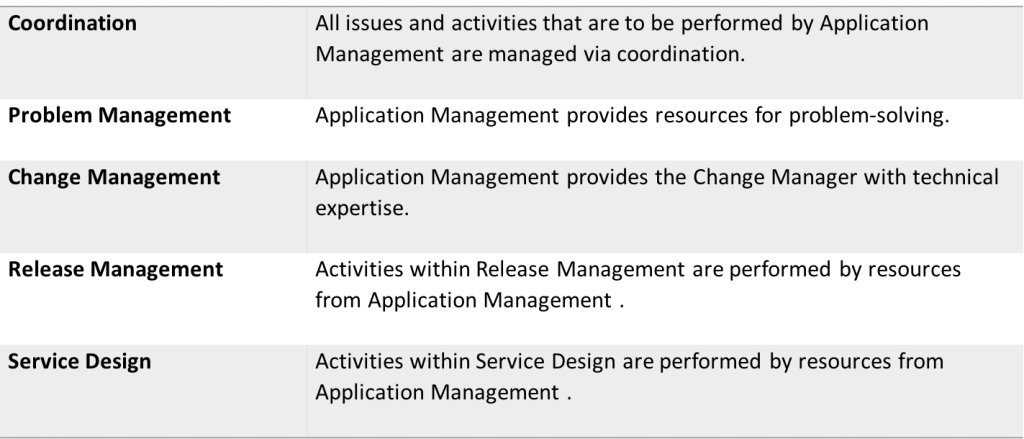The Application Management function should have control of all applications included in the IT environment. In distinction from Technical Management, the groupings which manage applications are often dispersed organizationally. Moreover, it is common that this function is managed by a supplier. Many IT organizations set up groups for the major business systems. These groupings are described in this book as Delivery Management functions. Even excluding the major systems and applications, there are usually several hundred applications included in the IT environment and these also need to be managed.
This means that the Application Management’s task is divided into two parts. The main responsibility is that it must be possible to deliver all applications included in the IT environment together with the infrastructure as a stable IT service to the business. For some of these applications there is a separate grouping responsible for the management of a specific system. In these cases, Application Management is responsible for operation and coordination. For all other applications, Application Management is responsible for both operation and management.


Purpose
The purpose of Application Management is to act as the IT organization’s experts in the applications included in the IT environment. It entails supplying expertise for design, testing, deployment, ongoing maintenance and continual service improvement of applications.
The function must also provide all application resources to other parts of the IT organization. Application Management ensures that staff and contracted resources have sufficient training and knowledge to participate in projects, maintain the application environment and implement improvement measures.
In fulfilling these two purposes, Application Management ensures that the IT organization has access to the amount of resources and the level of expertise that is required in order to meet the levels agreed with the business.
Responsibility
Application Management’s overall responsibility is to plan, deploy and maintain applications in the IT environment. It also includes continuously endeavoring to achieve as stable and cost-effective application environment as possible.
Application Management’s responsibility comprises, but is not limited to:
- Identifying and establishing the knowledge and procedures required to manage administration and the operation of the applications
- Producing and administering an application policy for IT
- Producing and administering an application portfolio for IT
- Acting as escalation point for issues which involve applications
- Providing expert skills in relation to all applications in the IT environment.
- Processing orders which arrive via the Request Fulfilment process
- Providing resources for Problem Management which can assist in locating problems in applications
- Staffing projects and major activities requiring expertise
- Acting as experts and advisers in relation to procurement and development of new applications
- Assisting the Change Manager as experts
- Performing activities in the Release Management process
- Holding training courses and producing training material and documentation targeted at users and Service Desk
- Responsibility that the documentation of applications in the IT environment is always complete and correct
Organization and working method
Fundamentally the same activities are required to administer the infrastructure or a system. The major difference is that a system is more complex and usually requires several different types of expertise. It also requires more input from the business in the form of requirements that development of the system should harmonize with development of the business. For this reason, separate management groups are often set up around specific systems.
The Application Management function must be established with respect to any existing system management organizations, and a thorough specification must be drawn up of who is responsible for what throughout the system’s life-cycle. The same applies when management of a system or an application is managed by a supplier.
System management groups sometimes use their own management model to ensure the business’s participation in development of the system. An important task for Application Management is to coordinate the System management model with the processes and procedures used within the rest of the IT organization in order to avoid misunderstandings and duplication of work.
The major difference between Technical Management and Application Management is that Application Management is rarely a separate organizational unit, but rather a functional responsibility which is located in several different organizations, both internal and external. This means that the function has an important responsibility to consolidate and coordinate the entire application portfolio.
Input
The overall input to Application Management is the issues which arrive via Coordination. More specifically, input consists of:
- Problems
- Orders
- Operational Maintenance
- Projects
- Improvement activities
Output
The overall output from Application Management is a stable and cost-effective application environment. More specifically, output consists of:
- Resolved problems
- Processed orders
- Operational Maintenance performed
- Improvement activities implemented
- Changes deployed
Documentation
All documents produced by the function must be available in a business system. The most important documents are:
- Application portfolio
- Application policy
- Documentation available for all applications included
- Known bugs
- Administration procedures
- User manuals
- Maintenance schedule with activities
- Inventory of expertise
- Release procedures
Relationships with other processes and functions
Application Management has links with many other processes and functions. The most common are listed here:


